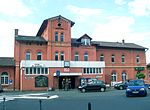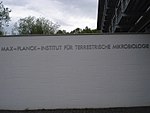Transformatorenhäuschen (Anzefahr)
Buildings and structures in Marburg-BiedenkopfCulture of HesseFormer power stations in GermanyTowers completed in the 20th centuryTowers in Germany

The Transformatorenhäuschen (literally ‘little transformer house’) is a former electrical distribution substation on the Sindersfelder Straße in Anzefahr, a borough of the Hessian city of Kirchhain in Marburg-Biedenkopf district. The tower-like building was erected during the first quarter of the 20th century and connected Anzefahr to the power grid. Built from brick, the Transformatorenhäuschen is plastered. Both the corners and window cutouts feature sandstone. As a “witness of the beginning of electrification in rural areas” („als Zeuge für den Beginn der Elektrifizierung auf dem Lande“), the Transformatorenhäuschen is protected as a cultural heritage monument.
Excerpt from the Wikipedia article Transformatorenhäuschen (Anzefahr) (License: CC BY-SA 3.0, Authors, Images).Transformatorenhäuschen (Anzefahr)
Sindersfelder Straße,
Geographical coordinates (GPS) Address Nearby Places Show on map
Geographical coordinates (GPS)
| Latitude | Longitude |
|---|---|
| N 50.846233 ° | E 8.863896 ° |
Address
Trafoturm Anzefahr
Sindersfelder Straße
35274 (Anzefahr)
Hesse, Germany
Open on Google Maps










